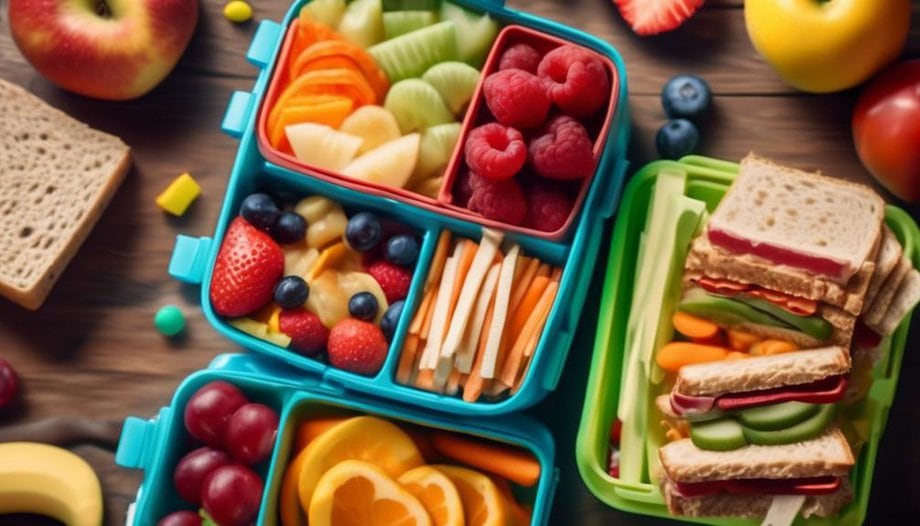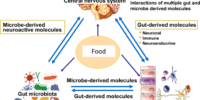How to Establish Healthy Eating Routines for School-Aged Kids

Tips for Establishing Healthy Eating Routines for School-Aged Kids:
- Family meal times
- Embracing breakfast
- Addressing picky eating
- Involving kids in meal planning
- Reading nutrition labels
- Prioritizing water
- Setting limits on snacks.
Set Family Meal Times
Set specific meal times for your family and stick to them consistently to establish healthy eating routines. Having designated meal times creates a sense of structure and routine for your children, helping them develop healthy habits. Consistency is key when it comes to establishing these routines, as it allows your children to know what to expect and helps them make healthier choices.
Family meal times are a great opportunity to introduce nutritious foods and encourage a variety of healthy choices. Make it a priority to gather everyone around the table for meals. This not only promotes family bonding, but also creates a positive and relaxed atmosphere for your children to enjoy their meals.
To further involve your children in the process, encourage them to participate in meal preparation and planning. This not only teaches them valuable cooking skills, but also empowers them to make their own healthy choices.
In addition to setting meal times, it's important to ensure that the meals provided are balanced and include a variety of foods. Incorporate fruits, vegetables, whole grains, lean proteins, and dairy products into your family's meals.
Lastly, remember to encourage physical activity as part of your family's routine. Engaging in regular physical activity alongside healthy eating habits will help your children develop a well-rounded and healthy lifestyle.
Embrace Breakfast
To continue establishing healthy eating routines, it's important to prioritize breakfast as a key component of your child's growth and development. A healthy breakfast provides the essential nutrients your child needs to start their day off right. It sets the tone for their eating habits and can improve their overall well-being.
When planning breakfast, aim for simple and nutritious options. Whole-wheat toast with natural peanut butter or plain Greek yogurt with fruit are excellent choices. These foods are packed with vitamins, minerals, and fiber, which support your child's metabolism and keep them energized throughout the day.
Teaching your child about the importance of breakfast is crucial. Help them understand that breakfast provides the fuel their body needs for physical activity and concentration at school. By emphasizing the significance of breakfast, you can instill healthy habits that will benefit them in the long run.
Additionally, make sure to educate your child on appropriate serving sizes. Portion control is key to maintaining a balanced diet. Encourage them to listen to their body's hunger and fullness cues, and avoid overeating.
Address Picky Eating Early
Addressing picky eating early is crucial for establishing healthy eating habits in school-aged kids. It's important to be patient and persistent when introducing new foods to picky eaters. Encourage them to try new foods multiple times by implementing a three-bite rule. Understand that it may take several attempts for children to develop a liking for certain foods.
When serving meals and snacks, offer a variety of healthy foods, including fruits and vegetables, to encourage exploration and exposure. Allow children to choose from the options provided, but avoid making separate meals. By doing so, you're teaching them to make healthy choices and develop a well-rounded palate.
Incorporating meal planning into your routine can also help ensure that you're providing nutritious and balanced meals. Remember, establishing healthy eating habits early on sets the foundation for a lifetime of good health.
Encourage physical activity along with healthy meals to promote overall wellness. By addressing picky eating early and offering a variety of healthy foods, you can help your child develop a love for nutritious eating and establish lifelong healthy eating habits.
Involve Kids in Meal Planning and Prep
When it comes to establishing healthy eating habits in school-aged kids, involving them in meal planning and preparation can be a valuable tool. By including children in these activities, you not only teach them about healthy food choices, but also give them a sense of ownership and responsibility over their own meals.
One way to involve kids in meal planning is by taking them to the grocery store and letting them make simple choices. Allow them to pick out a vegetable for dinner, which can increase their willingness to eat it. This empowers them to make decisions about what they want to eat, while still ensuring that they're choosing healthy foods.
In the kitchen, give your children age-appropriate tasks such as mixing ingredients or washing fruits and veggies. Engaging them in the creation of family meals and snacks fosters their independence and investment in their own health. Make meal preparation a bonding opportunity and use it as a time to teach them about nutrition.
When it comes to snacks, involve your kids in the process of making healthy choices. Offer options like whole wheat crackers with peanut butter or apple slices with a small cup of fruit juice. Eating together as a family and involving children in meal planning and prep not only promotes healthy eating habits, but also strengthens family bonds.
Read the Nutrition Labels
Understanding how to read nutrition labels is an essential skill for making informed and healthy food choices for your child's diet. By familiarizing yourself with nutrition labels, you can assess the health value of a product based on serving sizes, calories, and nutrient content. Here's a breakdown of how to effectively read nutrition labels:
- Pay attention to serving sizes: Serving sizes may vary from what your child actually consumes, so be mindful of the recommended serving size to understand the nutritional information accurately.
- Assess calories and nutrient content: Look for products that are lower in calories and higher in essential nutrients such as vitamins, minerals, and fiber. This ensures your child gets the necessary nutrients for their health.
- Check for added sugars, saturated fats, and sodium: These ingredients should be limited in your child's diet. Opt for products with lower amounts of added sugars, saturated fats, and sodium to promote better health.
Teaching your child to read nutrition labels empowers them to make healthy food choices and understand the nutritional content of different foods. Use the information on nutrition labels to compare similar products and make healthier choices for your child's snacks and meals. By incorporating this skill into their daily routine, you can promote a balanced and nutritious diet for your child's overall well-being.
Make Water a Priority
To promote optimal health and hydration, prioritize water as the go-to beverage choice for school-aged kids. Encouraging children to drink at least 40 ounces (5 cups) of water per day is essential for their overall well-being. By teaching kids about the importance of staying hydrated and the benefits of drinking water throughout the day, we can instill healthy habits that will benefit them for a lifetime.
To emphasize the significance of water, it's helpful to compare it to other popular beverages. Take a look at the table below to see how water stacks up against some common drink choices:
| Beverage | Sugar Content (per 8 oz) | Benefits |
|---|---|---|
| Water | 0g | Hydrates the body and aids in digestion |
| Fruit Juice | 24g | Provides some vitamins, but high in sugar |
| Soda | 26g | High sugar content with no nutritional benefits |
| Sports Drinks | 21g | Contains electrolytes, but high in sugar and calories |
| Flavored Milk | 12g | Contains essential nutrients, but also high in sugar |
As you can see, water has zero grams of sugar and provides numerous benefits for your child's health. By making water easily accessible and a convenient choice, you can ensure that your child stays hydrated throughout the day. Avoid sugary drinks and encourage water as the primary beverage option. As a role model, make water a priority for the whole family by drinking it regularly yourself.
Set Limits on Snacks
Now that you've established the importance of prioritizing water as the go-to beverage choice for school-aged kids, it's time to address the next crucial step in promoting healthy eating routines: setting limits on snacks.
By setting limits on snacks, you can help your child develop healthy eating habits that will benefit their overall health and well-being. Here are some strategies to help you set limits on snacks:
- Establish specific snack times: By establishing specific snack times, you can prevent constant grazing throughout the day. This will help your child recognize when it's time to eat and when it's time to focus on other activities.
- Limit the availability of unhealthy snacks: Keep unhealthy snacks out of sight and opt for healthier options instead. By providing your child with a variety of healthy foods, you can help them stay away from fast food and other unhealthy choices.
- Encourage regular, balanced meals: Encourage your child to eat regular, balanced meals that include a variety of fruits, vegetables, whole grains, and lean proteins. This will help reduce the urge for excessive snacking and provide your child with the nutrients they need for optimal growth and development.
Frequently Asked Questions
What Are the Guidelines for Healthy Eating for School Aged Children?
To establish healthy eating routines for school-aged kids, follow these guidelines: provide balanced meals with proper portion control, limit sugary snacks, encourage fruits and vegetables, offer healthy snack options, prioritize hydration, limit processed foods, and teach kids about nutrition.
How Do You Establish Healthy Eating Habits for Kids?
To establish healthy eating habits for kids, plan meals, control portions, offer balanced snacks, cook together, limit sugary drinks, incorporate fruits and veggies, teach mindful eating, and encourage family meals.
What Are the Healthy Eating Habits for School Going Children?
To establish healthy eating habits for school-aged kids, focus on balanced meals, nutritious snacks, portion control, limiting processed foods, incorporating fruits and vegetables, drinking plenty of water, being mindful of sugar intake, encouraging family meals, and teaching kids to listen to their bodies' hunger and fullness cues.
How Parents Can Help School Age Children Develop Healthy Eating Habits By?
To help your school-age child develop healthy eating habits, focus on meal planning, portion control, and encouraging variety. Limit sugary drinks, teach mindful eating, involve them in meal prep, and set a good example. Make healthy snacks accessible and create a positive food environment.











